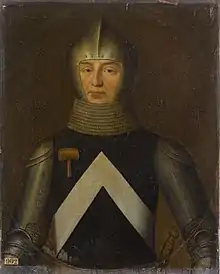Robert de Bracquemont
Robert de Bracquemont or Mosén Rubí de Bracamonte, also known as Rubín and as Braquemont (1350s-1419), 1st Lord of Fuente el Sol and Rubí de Bracamonte, was a Norman nobleman, who served as Admiral of France and Castile.[1]
Robert de Bracquemont | |
|---|---|
 | |
| Governor of Honfleur | |
| In office 1415–1417 | |
| Monarch | Charles VI of France |
| Preceded by | ? |
| Succeeded by | ? |
| Personal details | |
| Born | c.1340 Normandy, France |
| Died | April 4, 1419 Mocejón, Toledo, Spain |
| Occupation | politician |
| Profession | Army's officer |
| Military service | |
| Allegiance | Kingdom of France Crown of Castile |
| Rank | Admiral of France |
Biography
Robert was the fourth son of Renaud II de Bracquemont, and grandson of Regnault I de Bracquemont and Isabel de Bethencourt.[2] His first wife was Inés González de Mendoza, daughter of Pedro González de Mendoza and Aldonza Fernández de Ayala, belonging to the powerful House of Mendoza.[3]
He arrived in Castile in 1386, as French ambassador to the Castilian court of Henry III.[4] In 1415 Robert de Bracquemont became an Admiral of France. Between 1415 and 1417 he served as governor of Honfleur.
He was given certain royal prerogatives at Mocejón in Toledo, where he died in 1419.[5]
References
- Nobiliario de los reinos y señorios de España. Francisco Piferrer. 1858. p. 22.
Mosén Rubí de Bracamonte.
- Les conseillers du Parlement de Normandie: Sous Henri IV et sous Louis XIII (1594-1640), Volumes 2-3. Henri de Frondeville. 1964.
- DISCURSOS HISTORICOS DE LA MUY NOBLE Y MUY LEAL CIUDAD DE MURCIA. Francisco Cascales. February 2007. ISBN 9788497613460.
- Bernage, Georges. "Jean de Bethencourt, King Canary", Heritage Normand, No. 31, February - March, 2000
- "Juan G. Atienza insinúa el origen masónico de la Capilla de Bracamonte en Ávila". La Información (in Spanish). 21 October 2009. Retrieved 28 January 2022.
Robert de Braquemont, castellanizado como Rubín o Rubí de Bracamonte, sirvió en España a los reyes Juan I, Enrique III y Juan II, de quienes obtuvo mercedes, territorios y señoríos como los de Fuente el Sol (Valladolid), Peñaranda (Salamanca) y Mocejón (Toledo), donde finalmente falleció